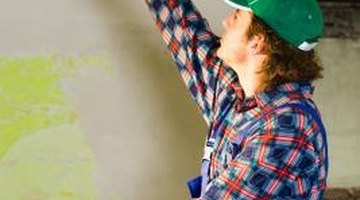How to Plaster With Marble Dust
Adding marble dust to plaster is part of a plastering technique known as Venetian plaster. The addition of the marble dust creates a semi-gloss textured surface that's quite different from the plain white plaster created without the addition of the marble material. Since the marble dust comes in a large variety of colors, the plaster takes on a colored sheen that changes with the play of light across its surface. Applying the plaster is as much an art as it is a technique, but by following the proper procedure, you can create beautifully textured surfaces that enhance any room in which you apply the plaster.

-
Clean the surface that you're applying the plaster to with a pH-neutral cleanser and a sponge. Wash away any dirt or debris with the damp sponge, taking care not to saturate the surface with moisture. Rinse the surface after washing with clean water, and then pat the surface dry with a clean cloth. Place a drop cloth along the base of the surface to protect the floor.
-
Put on a pair of safety goggles and a facemask to protect your eyes and lungs during the plastering project. Open any windows or doors to the area to improve ventilation as well.
-
Scarify any glossy finish present on the surface by scratching the surface with 100-grit sandpaper. Run the sandpaper over the surface in small circles to cover the surface with a series of tiny scratches that will help with plaster adherence. Wipe the surface after sanding it with a slightly damp cloth to remove any sanding residue.
-
Open the bucket containing the Venetian plaster. Fill the blade of a trowel with the plaster and then apply the plaster to your surface with the trowel tilted to an angle between 15 and 30 degrees. Spread the plaster using random strokes to cover the surface while creating a textured surface; leaving the occasional bald area is fine. Remove drying plaster from the trowel blade while spreading the material to avoid leaving clumps of plaster on the surface. Wait four hours for the first coat of plaster to dry.
-
Apply the second coat of plaster to your surface with the trowel nearly flat, held at a 60- to 80-degree angle. Cover the surface completely with the second coat using alternating long and short strokes of the trowel to apply the plaster. Fill in any voids left by the first coat with the second coat of plaster, and make an effort to leave no edge marks from the trowel. Go over any edge marks created with the trowel a second time to blend them into the surrounding plaster surface. Wait 24 hours drying time for the second coat.
-
Apply a final topcoat to protect the two coats below. Use the steel trowel tilted to a 15- to 30-degree angle to spread a final thin layer of plaster over the other two. This final layer creates a slight sheen to the plaster and provides an easily washed surface. Wait 24 hours for the topcoat to dry.
-
Sand down the plaster using a 400-grit sandpaper to remove any rough spots from the application. Use a circular motion to sand the plaster lightly. Be careful when sanding so that you don't sand through the plaster layers. Wipe down the surface with a damp cloth to remove any sanding residue and to complete the plaster application.
Writer Bio
Larry Simmons is a freelance writer and expert in the fusion of computer technology and business. He has a B.S. in economics, an M.S. in information systems, an M.S. in communications technology, as well as significant work towards an M.B.A. in finance. He's published several hundred articles with Demand Studios.
Photo Credits
- Jupiterimages/Photos.com/Getty Images
More Articles



